Sold out! Many thanks to all who ordered!
The editor…
By Carl Goodwin
Would you like a 220 HP Alfa?
In the heyday of U.S. importer Alfa Romeo Inc. – that would be the late ‘60s to the late ‘90s – a bright, enthusiastic engineer named Don Black managed Alfa’s racing activities during his evenings and weekends.
With the help and support of the president of the organization, Arturo Reitz, he organized contingency programs for Alfa racers. For those drivers who finished 1st, 2nd or 3rd in class, they got $300, $200 or $100. It doesn’t sound like much now, but in 1971 it was a nice payoff. During the first year of this program, the five leading drivers were given a brand new Alfa 2600 roadster for their accomplishments!
To keep Alfas ahead of the competition, with a name that often began with the letter P and was built in Bavaria, Don Black’s racer support program also provided technical advice. “We were just reporting things,” Don commented. “Some of the teams were ahead of us.” Other information came from Autodelta and some came from Don Black’s engineering activities. Production was handled by Kathy Ruccio, who did the typing, printing, assembling and mailing of the information. New pages were issued weekly.
Racers who actively campaigned Alfas saved these technical bulletins. A wealth of valuable information was in them. After a while, 300 or so pages accumulated and Don thought it was time for a book. It was a simple production that emphasized content and information rather than style. And it had a green cover, thus, “The Green Book,” formally titled “Alfa Romeo Competition Reference Handbook” or CRH for short.
The information in this wondrous tome was so complex and so detailed that as soon as you look at it you think “this should be titled ‘Instructions to a Machine Shop’.”
After the Table of Contents, the first sentence of the book reads “Magnaflux each rod individually and against each other and as a group.” You know you are getting serious stuff when it starts like this. It is not for entertainment.
Let’s get ahead of ourselves and see what all this effort will bring us. There are sample dyno sheets at the end of the section titled “1. Power Plants.” The highest reading is seen on a graph of various engines with the 1900cc fuel injected four-valve engine reaching 220 HP at 7300 RPM, after which power output falls off rapidly.
If you don’t have a four-valve engine, how about this one: 1750cc carbureted two-valve engine, 158 HP at 7400 RPM or 1698cc carbureted twin plug two valve engine, 175 HP at 7499 RPM or 1300 GTA carbureted two valve engine, 141 HP at 7400 RPM.
The Green Book is neatly organized into Engine, Drive Train (important gear ratios and limited slip rear axles), Suspensions (including spring rates), Wheels and Brakes, Chassis and Body, et cetera. Nothing is missed. Well, the book is a little light on the early models such as early Giuliettas, but covers the late Giuliettas except drum brakes, Giulia 105s including GTAs, Touring 2000 (model 102) and Touring 2600 (model 106). While the 105 model, with the 1600 and 1750 engines, is really the area of interest, the book does delve into unusual applications including marine conversion equipment for both the four cylinder engines and the V-8 Montreal.
For those who didn’t really want to build an engine, there were several options for factory built power plants, culminating with the 220 HP GTAm of 1971. Don Black comments “There was very little interest in these factory engines because racers were under the impression that they could build an engine that was just as good for less expense.”
Finally, in the back of The Green Book are two very interesting sections. One is very dryly titled “Homologation.” It is full of fascinating bits about what the various sanctioning bodies will permit, and what they won’t, parsed in very direct language, per this bit of advice from Don Black “…don’t get caught [with these oversize fender flares].” Information that is out of date in “regular” racing will serve you well in the vintage events.
Preceding this section is a panoply of illustrated performance parts from “glazing in plexiglass” to “aluminum doors with descending window” To “differential housing for use with sliding block locator” and “Lucas Injection Conversion.”
If you think you will buy one, act fast because we only have a handful of copies left.
User Endorsements: Ed Wachs, Chicago Region SCCA
Ed drove a 2-liter Alfa GTA in 1971 and ’71, in the Trans-Am Under 2-liter Series. Ed did not actually use the entire Green Book. Instead, he was in the racer support program and received the weekly bulletins from Alfa Romeo Inc., thereby getting the book in installments. He also got advice and special parts from Don Black. “Don was a good guy and very appreciative of our efforts,” says Wachs. “He got us a lot of parts from Autodelta – some engine parts and some special suspension parts including sway bars and front links. Our engine was the standard twin-plug carbureted version. It dynoed in the high twos. We used 8500 RPM. We rebuilt the engine almost every race. With the pistons it used, we consumed a lot of oil. To top it up in endurance races, we used a scuba tank filled with oil and pressurized at 40 pounds. We had a fitting on top of the hood and we could fill 3 quarts in 5 seconds.”
User Endorsements, Keith Goring, Alfas Unlimited
Keith brought up a point that most restoration/race shops will appreciate. Although no doubt that Don’s work is now a “Classic” on its own, the problem is that the original parts are no longer available. “I view this book as ancient history; very cool, but not much help,” says Goring.
“For example; Alfa(Autodelta) had Borgo make a number of different “slipper” pistons to use in the race engines. They had rounded domes and cutaway slipper skirts which gave about a 10-1 compression ratio. Then, to get more compression, they cut the head to lower it down over the piston crown. Cutting a twin plug GTA head would be a sacrilege these days. Nowadays, everyone uses pistons with a plateau top which allows higher compression without as much machining of the head surface.
“The CRS specs out GTA or Veloce con rods; everyone now used Carillo or similar H-beam rods which are much stronger. Original GTA nitrided crankshafts are near impossible to get, as are the original lightened steel flywheels. Aluminum flywheels have become the norm, now. Same with cams, New and better grinds are easily available.”
But as everyone agrees, not only is the book a classic, but despite the use of new parts and new methods, there is still a great deal of useful information in the book that’s still valid. And wouldn’t it be nice to restore a GTA with original parts? An impossible dream perhaps…one that Dean Russell has had…
User Endorsements, Dean Russell, Trail Auto, Ann Arbor www.trailauto.com; trailauto@sbcglobal.net
Dean Russell has an all-around Alfa restoration, repair and race-prep shop and knows everything. He found one of those “unavailable” flywheels (I think it was 105 teeth – or was it 101? – anyway it came from some mysterious place in Germany). He races an Alfa sedan himself and bought his first Alfa in 1972, says “I have relied on the CRH for various nuggets of information, part numbers, etc. There is a wealth of information in it, part numbers, methods and procedures, and items and sources available outside of the Alfa umbrella. It touches on preparation topics and rules for racing classes outside of our SCCA, including European Formula classes and marine engines. A greater wealth of clues in the CRH will aid one researching topics in deeper detail than what the guide covers.” He has known Don Black for years, recalling that “Don helped me to expand my service library for the 1990+ cars which were equipped with updated injection systems, ABS, and air bags. I helped him with some of his personal projects, an Alfa powered sprint car and a GTV6, most memorably.”
Trail Auto, 24349 Ann Arbor Trail, Dearborn Heights, MI 48127 (313)561-3327.
Below, (click images to enlarge) eight sample pages from the Green Book, including:
GTAm head porting specs
Competition headers, Montreal
Montreal Dyno sheet
Optional ratios for 116 transaxles
GTA spring rates
Mph/gear ratio with different tires
1750-GTA engine dimensions
Part number key
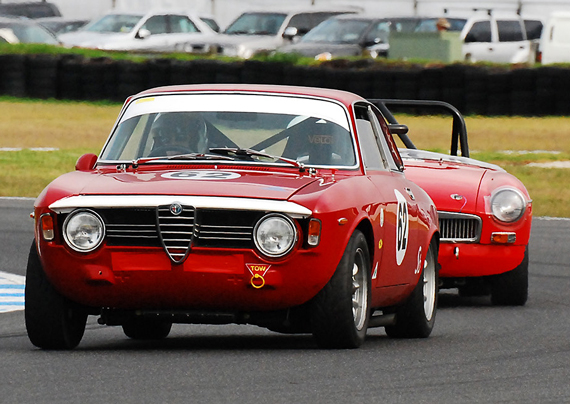
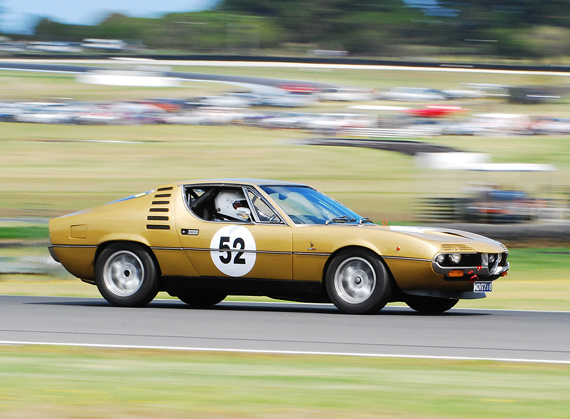
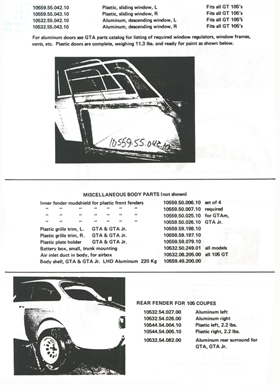

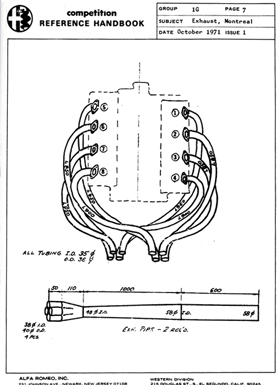
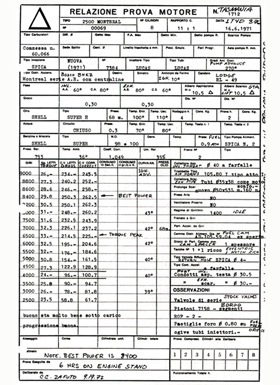

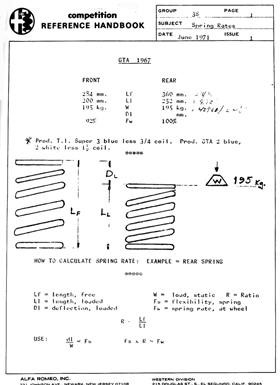
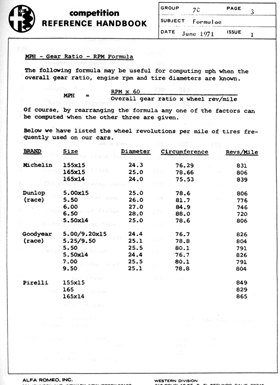
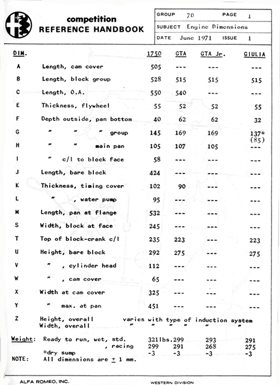
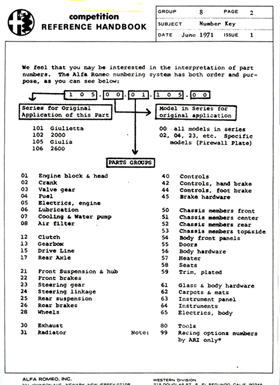
I would recommend Don’s Competition Reference Handbook in much the same manner as Fusi’s original “All Cars Since 1910” Alfa Romeo volume…it should be the law that all Alfa Romeo racing or gymkhana enthusiasts must own and use it as a reference. Just one paragraph of information might save you $125 in lost effort or wasted parts purchases or machine shop time…or out of spec machining. You never know what it is you don’t know. I have relied on the wisdom of the book in my earlier years driving 105 series cars and it always served me well.
Wow, what a great find . I wish you had more of them !
Yes the Don Black book and the green Alfa Romeo Competition parts book are great sources of historical information, I have them both. Of course current best practice is another matter, just ask Peter Axford who is shown driving his fantastic red 1964 GT Sprint. Peter and the team at Eurosport in Adelaide also prepared Dale Ashby’s magnificent 1974 gold Montreal, both drivers are pictured in action at the recent Phillip Island Classic Festival of Motor Sport 2015 in Australia where over 511 entries were recorded for the 2 day event in early March.
Hey, does anyone has the contact of Dean Russell? I’ve trying to call him but the phone is no longer working.
Best,
Roberto